Cultural Safety and Social Determinants of Health Analysis
VerifiedAdded on 2023/06/10
|8
|1834
|244
Essay
AI Summary
This essay examines the social determinants of health, focusing on factors like social gradient, stress, unemployment, social exclusion, and social support, and their impact on health outcomes, particularly for marginalized groups like Aboriginal Australians. It discusses the historical context of policies affecting Aboriginal health, including protection policies and assimilation strategies, highlighting the role of institutional racism in perpetuating health inequities. The essay also explores the influence of traditional health beliefs on healthcare adherence, using the case study of Gift's mother to illustrate the challenges of cultural differences in healthcare settings. Furthermore, it emphasizes the importance of cultural safety in healthcare, advocating for health professionals to respect and understand patients' cultural identities to provide effective care. The essay concludes by highlighting the need for addressing cultural and social factors to improve health outcomes for diverse populations. Desklib offers a wealth of resources, including past papers and solved assignments, to aid students in further exploring these critical topics.
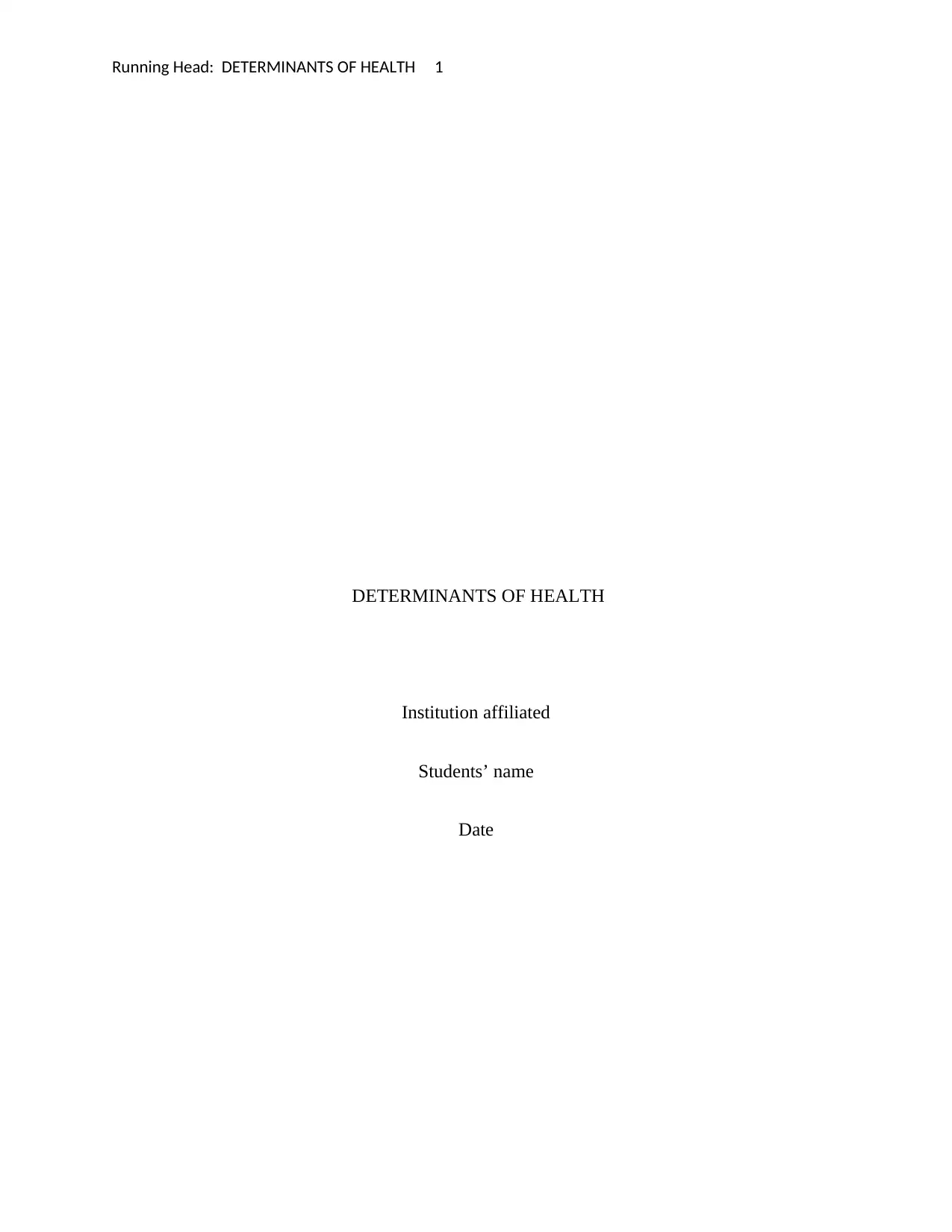
Running Head: DETERMINANTS OF HEALTH 1
DETERMINANTS OF HEALTH
Institution affiliated
Students’ name
Date
DETERMINANTS OF HEALTH
Institution affiliated
Students’ name
Date
Paraphrase This Document
Need a fresh take? Get an instant paraphrase of this document with our AI Paraphraser
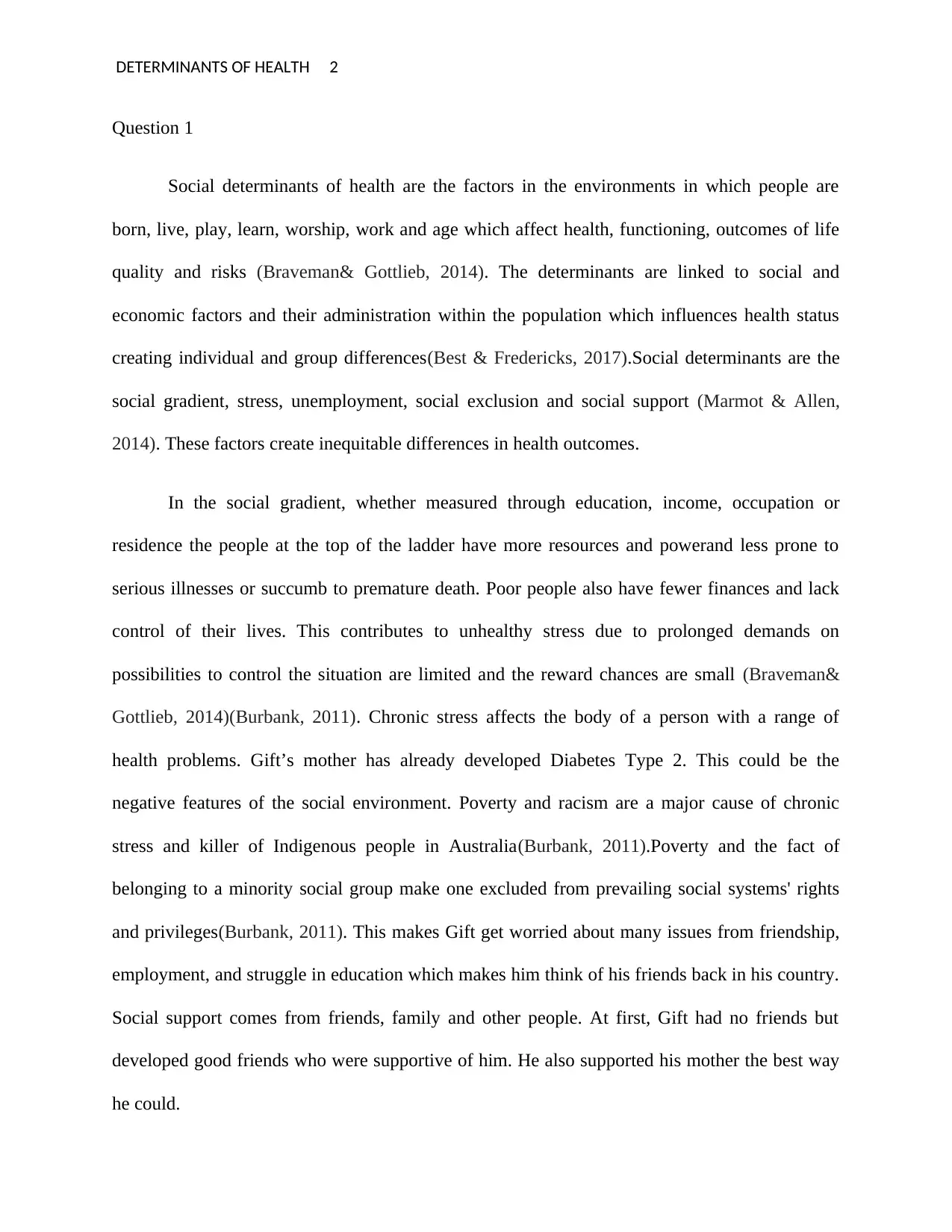
DETERMINANTS OF HEALTH 2
Question 1
Social determinants of health are the factors in the environments in which people are
born, live, play, learn, worship, work and age which affect health, functioning, outcomes of life
quality and risks (Braveman& Gottlieb, 2014). The determinants are linked to social and
economic factors and their administration within the population which influences health status
creating individual and group differences(Best & Fredericks, 2017).Social determinants are the
social gradient, stress, unemployment, social exclusion and social support (Marmot & Allen,
2014). These factors create inequitable differences in health outcomes.
In the social gradient, whether measured through education, income, occupation or
residence the people at the top of the ladder have more resources and powerand less prone to
serious illnesses or succumb to premature death. Poor people also have fewer finances and lack
control of their lives. This contributes to unhealthy stress due to prolonged demands on
possibilities to control the situation are limited and the reward chances are small (Braveman&
Gottlieb, 2014)(Burbank, 2011). Chronic stress affects the body of a person with a range of
health problems. Gift’s mother has already developed Diabetes Type 2. This could be the
negative features of the social environment. Poverty and racism are a major cause of chronic
stress and killer of Indigenous people in Australia(Burbank, 2011).Poverty and the fact of
belonging to a minority social group make one excluded from prevailing social systems' rights
and privileges(Burbank, 2011). This makes Gift get worried about many issues from friendship,
employment, and struggle in education which makes him think of his friends back in his country.
Social support comes from friends, family and other people. At first, Gift had no friends but
developed good friends who were supportive of him. He also supported his mother the best way
he could.
Question 1
Social determinants of health are the factors in the environments in which people are
born, live, play, learn, worship, work and age which affect health, functioning, outcomes of life
quality and risks (Braveman& Gottlieb, 2014). The determinants are linked to social and
economic factors and their administration within the population which influences health status
creating individual and group differences(Best & Fredericks, 2017).Social determinants are the
social gradient, stress, unemployment, social exclusion and social support (Marmot & Allen,
2014). These factors create inequitable differences in health outcomes.
In the social gradient, whether measured through education, income, occupation or
residence the people at the top of the ladder have more resources and powerand less prone to
serious illnesses or succumb to premature death. Poor people also have fewer finances and lack
control of their lives. This contributes to unhealthy stress due to prolonged demands on
possibilities to control the situation are limited and the reward chances are small (Braveman&
Gottlieb, 2014)(Burbank, 2011). Chronic stress affects the body of a person with a range of
health problems. Gift’s mother has already developed Diabetes Type 2. This could be the
negative features of the social environment. Poverty and racism are a major cause of chronic
stress and killer of Indigenous people in Australia(Burbank, 2011).Poverty and the fact of
belonging to a minority social group make one excluded from prevailing social systems' rights
and privileges(Burbank, 2011). This makes Gift get worried about many issues from friendship,
employment, and struggle in education which makes him think of his friends back in his country.
Social support comes from friends, family and other people. At first, Gift had no friends but
developed good friends who were supportive of him. He also supported his mother the best way
he could.
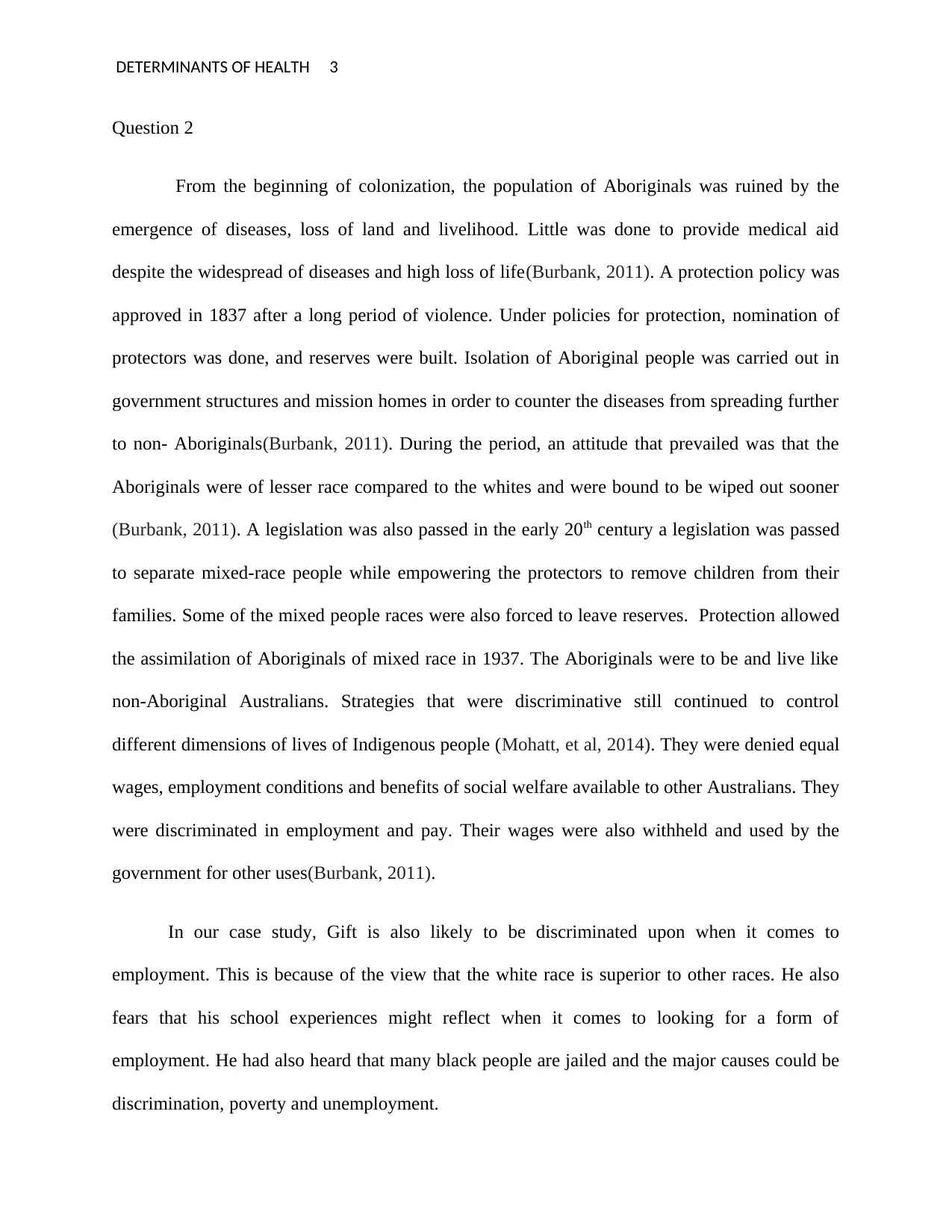
DETERMINANTS OF HEALTH 3
Question 2
From the beginning of colonization, the population of Aboriginals was ruined by the
emergence of diseases, loss of land and livelihood. Little was done to provide medical aid
despite the widespread of diseases and high loss of life(Burbank, 2011). A protection policy was
approved in 1837 after a long period of violence. Under policies for protection, nomination of
protectors was done, and reserves were built. Isolation of Aboriginal people was carried out in
government structures and mission homes in order to counter the diseases from spreading further
to non- Aboriginals(Burbank, 2011). During the period, an attitude that prevailed was that the
Aboriginals were of lesser race compared to the whites and were bound to be wiped out sooner
(Burbank, 2011). A legislation was also passed in the early 20th century a legislation was passed
to separate mixed-race people while empowering the protectors to remove children from their
families. Some of the mixed people races were also forced to leave reserves. Protection allowed
the assimilation of Aboriginals of mixed race in 1937. The Aboriginals were to be and live like
non-Aboriginal Australians. Strategies that were discriminative still continued to control
different dimensions of lives of Indigenous people (Mohatt, et al, 2014). They were denied equal
wages, employment conditions and benefits of social welfare available to other Australians. They
were discriminated in employment and pay. Their wages were also withheld and used by the
government for other uses(Burbank, 2011).
In our case study, Gift is also likely to be discriminated upon when it comes to
employment. This is because of the view that the white race is superior to other races. He also
fears that his school experiences might reflect when it comes to looking for a form of
employment. He had also heard that many black people are jailed and the major causes could be
discrimination, poverty and unemployment.
Question 2
From the beginning of colonization, the population of Aboriginals was ruined by the
emergence of diseases, loss of land and livelihood. Little was done to provide medical aid
despite the widespread of diseases and high loss of life(Burbank, 2011). A protection policy was
approved in 1837 after a long period of violence. Under policies for protection, nomination of
protectors was done, and reserves were built. Isolation of Aboriginal people was carried out in
government structures and mission homes in order to counter the diseases from spreading further
to non- Aboriginals(Burbank, 2011). During the period, an attitude that prevailed was that the
Aboriginals were of lesser race compared to the whites and were bound to be wiped out sooner
(Burbank, 2011). A legislation was also passed in the early 20th century a legislation was passed
to separate mixed-race people while empowering the protectors to remove children from their
families. Some of the mixed people races were also forced to leave reserves. Protection allowed
the assimilation of Aboriginals of mixed race in 1937. The Aboriginals were to be and live like
non-Aboriginal Australians. Strategies that were discriminative still continued to control
different dimensions of lives of Indigenous people (Mohatt, et al, 2014). They were denied equal
wages, employment conditions and benefits of social welfare available to other Australians. They
were discriminated in employment and pay. Their wages were also withheld and used by the
government for other uses(Burbank, 2011).
In our case study, Gift is also likely to be discriminated upon when it comes to
employment. This is because of the view that the white race is superior to other races. He also
fears that his school experiences might reflect when it comes to looking for a form of
employment. He had also heard that many black people are jailed and the major causes could be
discrimination, poverty and unemployment.
⊘ This is a preview!⊘
Do you want full access?
Subscribe today to unlock all pages.

Trusted by 1+ million students worldwide
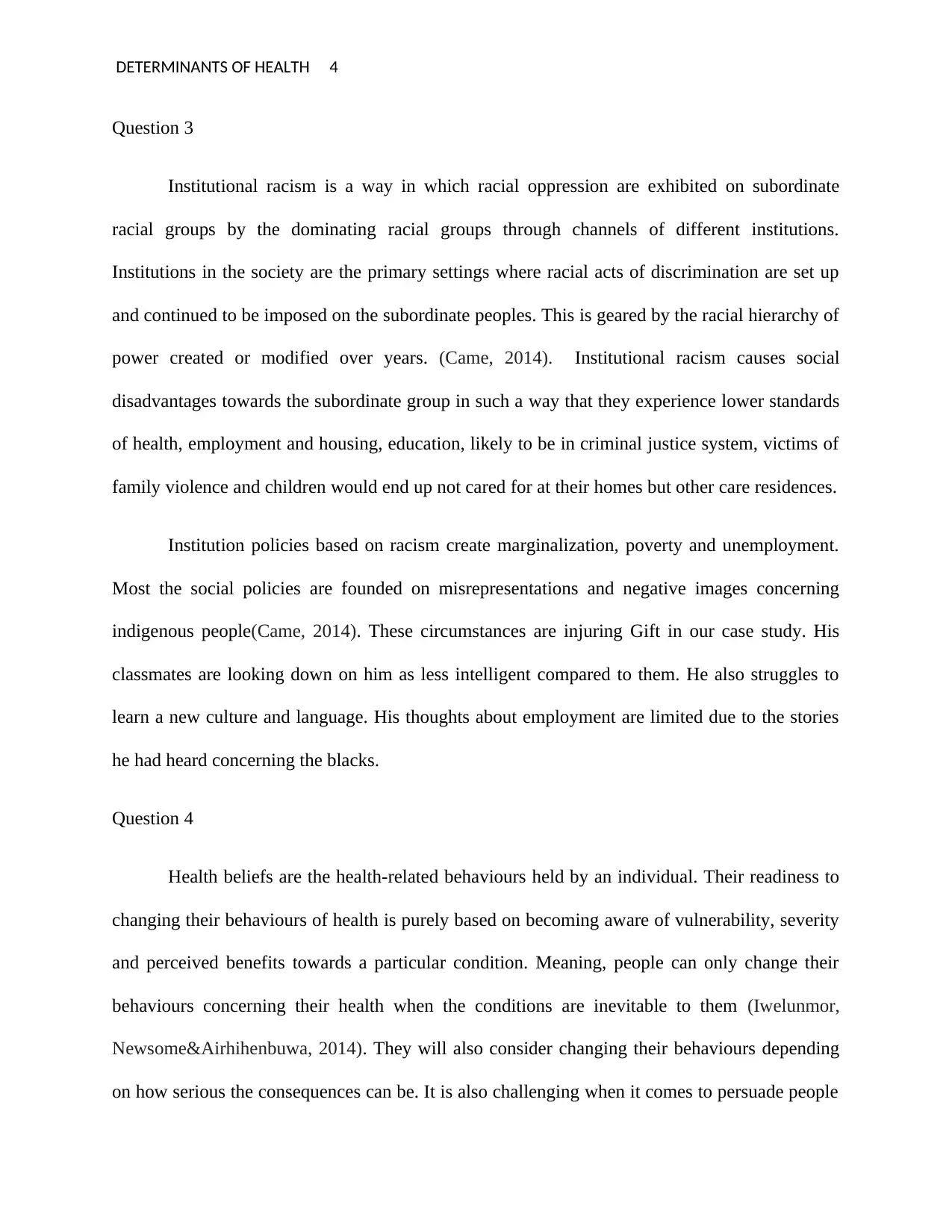
DETERMINANTS OF HEALTH 4
Question 3
Institutional racism is a way in which racial oppression are exhibited on subordinate
racial groups by the dominating racial groups through channels of different institutions.
Institutions in the society are the primary settings where racial acts of discrimination are set up
and continued to be imposed on the subordinate peoples. This is geared by the racial hierarchy of
power created or modified over years. (Came, 2014). Institutional racism causes social
disadvantages towards the subordinate group in such a way that they experience lower standards
of health, employment and housing, education, likely to be in criminal justice system, victims of
family violence and children would end up not cared for at their homes but other care residences.
Institution policies based on racism create marginalization, poverty and unemployment.
Most the social policies are founded on misrepresentations and negative images concerning
indigenous people(Came, 2014). These circumstances are injuring Gift in our case study. His
classmates are looking down on him as less intelligent compared to them. He also struggles to
learn a new culture and language. His thoughts about employment are limited due to the stories
he had heard concerning the blacks.
Question 4
Health beliefs are the health-related behaviours held by an individual. Their readiness to
changing their behaviours of health is purely based on becoming aware of vulnerability, severity
and perceived benefits towards a particular condition. Meaning, people can only change their
behaviours concerning their health when the conditions are inevitable to them (Iwelunmor,
Newsome&Airhihenbuwa, 2014). They will also consider changing their behaviours depending
on how serious the consequences can be. It is also challenging when it comes to persuade people
Question 3
Institutional racism is a way in which racial oppression are exhibited on subordinate
racial groups by the dominating racial groups through channels of different institutions.
Institutions in the society are the primary settings where racial acts of discrimination are set up
and continued to be imposed on the subordinate peoples. This is geared by the racial hierarchy of
power created or modified over years. (Came, 2014). Institutional racism causes social
disadvantages towards the subordinate group in such a way that they experience lower standards
of health, employment and housing, education, likely to be in criminal justice system, victims of
family violence and children would end up not cared for at their homes but other care residences.
Institution policies based on racism create marginalization, poverty and unemployment.
Most the social policies are founded on misrepresentations and negative images concerning
indigenous people(Came, 2014). These circumstances are injuring Gift in our case study. His
classmates are looking down on him as less intelligent compared to them. He also struggles to
learn a new culture and language. His thoughts about employment are limited due to the stories
he had heard concerning the blacks.
Question 4
Health beliefs are the health-related behaviours held by an individual. Their readiness to
changing their behaviours of health is purely based on becoming aware of vulnerability, severity
and perceived benefits towards a particular condition. Meaning, people can only change their
behaviours concerning their health when the conditions are inevitable to them (Iwelunmor,
Newsome&Airhihenbuwa, 2014). They will also consider changing their behaviours depending
on how serious the consequences can be. It is also challenging when it comes to persuade people
Paraphrase This Document
Need a fresh take? Get an instant paraphrase of this document with our AI Paraphraser
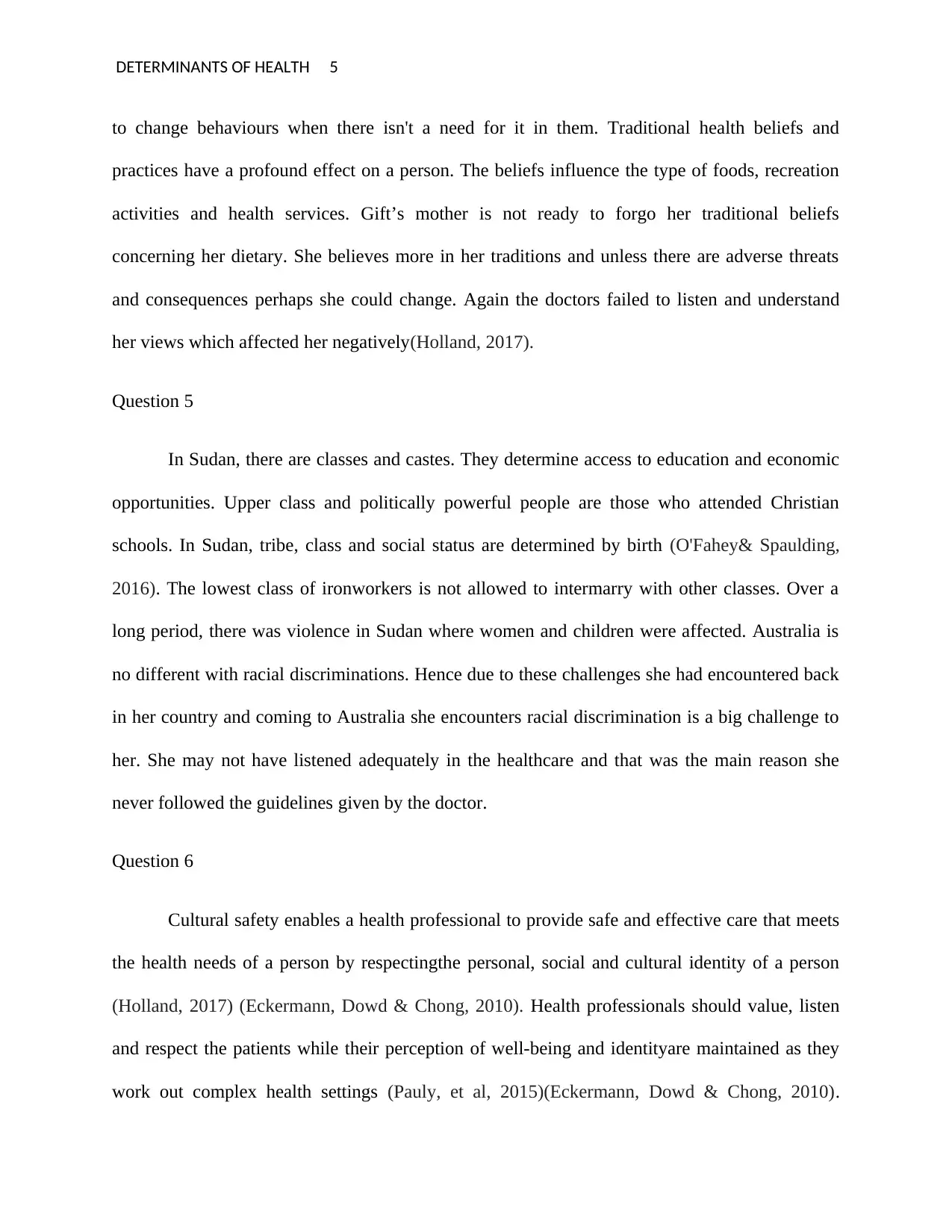
DETERMINANTS OF HEALTH 5
to change behaviours when there isn't a need for it in them. Traditional health beliefs and
practices have a profound effect on a person. The beliefs influence the type of foods, recreation
activities and health services. Gift’s mother is not ready to forgo her traditional beliefs
concerning her dietary. She believes more in her traditions and unless there are adverse threats
and consequences perhaps she could change. Again the doctors failed to listen and understand
her views which affected her negatively(Holland, 2017).
Question 5
In Sudan, there are classes and castes. They determine access to education and economic
opportunities. Upper class and politically powerful people are those who attended Christian
schools. In Sudan, tribe, class and social status are determined by birth (O'Fahey& Spaulding,
2016). The lowest class of ironworkers is not allowed to intermarry with other classes. Over a
long period, there was violence in Sudan where women and children were affected. Australia is
no different with racial discriminations. Hence due to these challenges she had encountered back
in her country and coming to Australia she encounters racial discrimination is a big challenge to
her. She may not have listened adequately in the healthcare and that was the main reason she
never followed the guidelines given by the doctor.
Question 6
Cultural safety enables a health professional to provide safe and effective care that meets
the health needs of a person by respectingthe personal, social and cultural identity of a person
(Holland, 2017) (Eckermann, Dowd & Chong, 2010). Health professionals should value, listen
and respect the patients while their perception of well-being and identityare maintained as they
work out complex health settings (Pauly, et al, 2015)(Eckermann, Dowd & Chong, 2010).
to change behaviours when there isn't a need for it in them. Traditional health beliefs and
practices have a profound effect on a person. The beliefs influence the type of foods, recreation
activities and health services. Gift’s mother is not ready to forgo her traditional beliefs
concerning her dietary. She believes more in her traditions and unless there are adverse threats
and consequences perhaps she could change. Again the doctors failed to listen and understand
her views which affected her negatively(Holland, 2017).
Question 5
In Sudan, there are classes and castes. They determine access to education and economic
opportunities. Upper class and politically powerful people are those who attended Christian
schools. In Sudan, tribe, class and social status are determined by birth (O'Fahey& Spaulding,
2016). The lowest class of ironworkers is not allowed to intermarry with other classes. Over a
long period, there was violence in Sudan where women and children were affected. Australia is
no different with racial discriminations. Hence due to these challenges she had encountered back
in her country and coming to Australia she encounters racial discrimination is a big challenge to
her. She may not have listened adequately in the healthcare and that was the main reason she
never followed the guidelines given by the doctor.
Question 6
Cultural safety enables a health professional to provide safe and effective care that meets
the health needs of a person by respectingthe personal, social and cultural identity of a person
(Holland, 2017) (Eckermann, Dowd & Chong, 2010). Health professionals should value, listen
and respect the patients while their perception of well-being and identityare maintained as they
work out complex health settings (Pauly, et al, 2015)(Eckermann, Dowd & Chong, 2010).
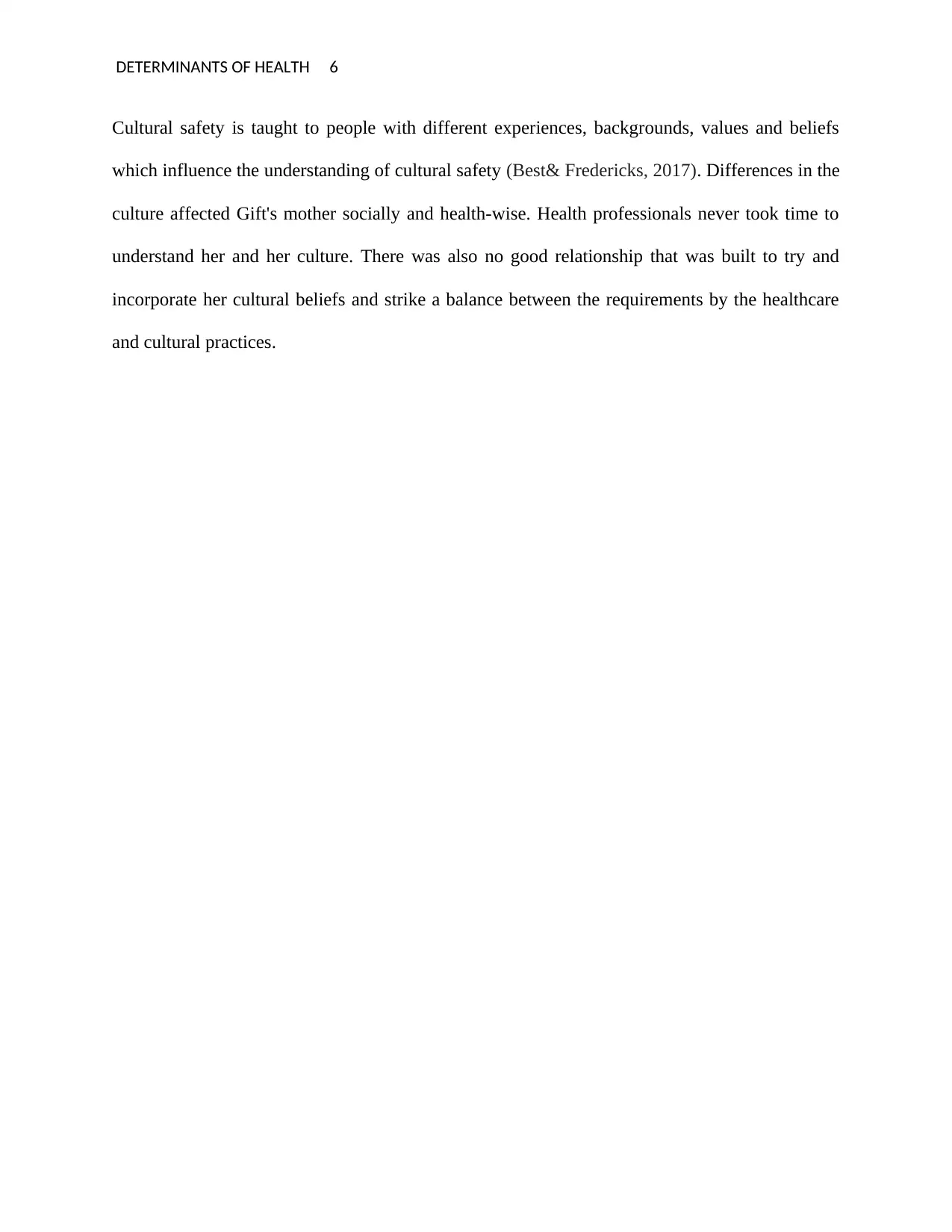
DETERMINANTS OF HEALTH 6
Cultural safety is taught to people with different experiences, backgrounds, values and beliefs
which influence the understanding of cultural safety (Best& Fredericks, 2017). Differences in the
culture affected Gift's mother socially and health-wise. Health professionals never took time to
understand her and her culture. There was also no good relationship that was built to try and
incorporate her cultural beliefs and strike a balance between the requirements by the healthcare
and cultural practices.
Cultural safety is taught to people with different experiences, backgrounds, values and beliefs
which influence the understanding of cultural safety (Best& Fredericks, 2017). Differences in the
culture affected Gift's mother socially and health-wise. Health professionals never took time to
understand her and her culture. There was also no good relationship that was built to try and
incorporate her cultural beliefs and strike a balance between the requirements by the healthcare
and cultural practices.
⊘ This is a preview!⊘
Do you want full access?
Subscribe today to unlock all pages.

Trusted by 1+ million students worldwide
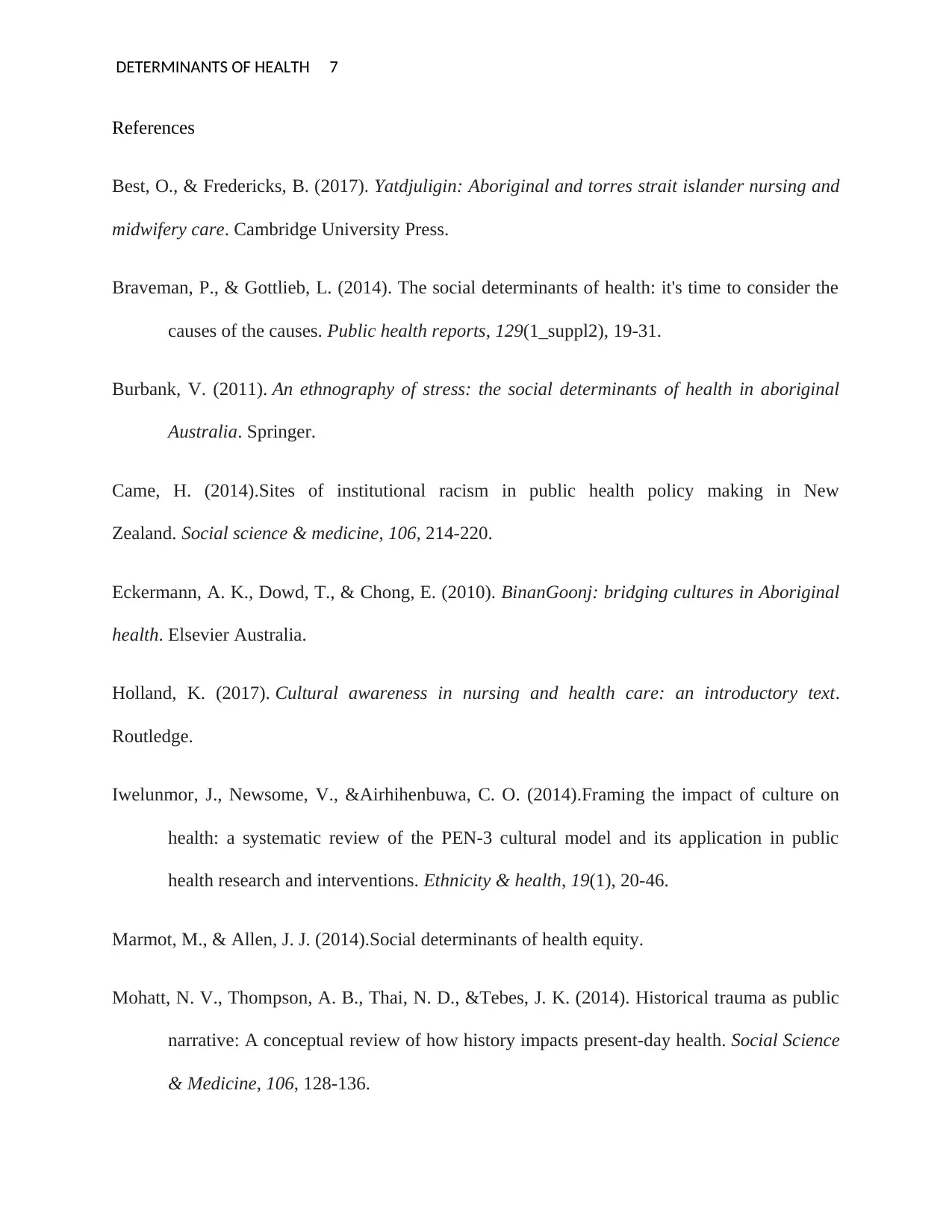
DETERMINANTS OF HEALTH 7
References
Best, O., & Fredericks, B. (2017). Yatdjuligin: Aboriginal and torres strait islander nursing and
midwifery care. Cambridge University Press.
Braveman, P., & Gottlieb, L. (2014). The social determinants of health: it's time to consider the
causes of the causes. Public health reports, 129(1_suppl2), 19-31.
Burbank, V. (2011). An ethnography of stress: the social determinants of health in aboriginal
Australia. Springer.
Came, H. (2014).Sites of institutional racism in public health policy making in New
Zealand. Social science & medicine, 106, 214-220.
Eckermann, A. K., Dowd, T., & Chong, E. (2010). BinanGoonj: bridging cultures in Aboriginal
health. Elsevier Australia.
Holland, K. (2017). Cultural awareness in nursing and health care: an introductory text.
Routledge.
Iwelunmor, J., Newsome, V., &Airhihenbuwa, C. O. (2014).Framing the impact of culture on
health: a systematic review of the PEN-3 cultural model and its application in public
health research and interventions. Ethnicity & health, 19(1), 20-46.
Marmot, M., & Allen, J. J. (2014).Social determinants of health equity.
Mohatt, N. V., Thompson, A. B., Thai, N. D., &Tebes, J. K. (2014). Historical trauma as public
narrative: A conceptual review of how history impacts present-day health. Social Science
& Medicine, 106, 128-136.
References
Best, O., & Fredericks, B. (2017). Yatdjuligin: Aboriginal and torres strait islander nursing and
midwifery care. Cambridge University Press.
Braveman, P., & Gottlieb, L. (2014). The social determinants of health: it's time to consider the
causes of the causes. Public health reports, 129(1_suppl2), 19-31.
Burbank, V. (2011). An ethnography of stress: the social determinants of health in aboriginal
Australia. Springer.
Came, H. (2014).Sites of institutional racism in public health policy making in New
Zealand. Social science & medicine, 106, 214-220.
Eckermann, A. K., Dowd, T., & Chong, E. (2010). BinanGoonj: bridging cultures in Aboriginal
health. Elsevier Australia.
Holland, K. (2017). Cultural awareness in nursing and health care: an introductory text.
Routledge.
Iwelunmor, J., Newsome, V., &Airhihenbuwa, C. O. (2014).Framing the impact of culture on
health: a systematic review of the PEN-3 cultural model and its application in public
health research and interventions. Ethnicity & health, 19(1), 20-46.
Marmot, M., & Allen, J. J. (2014).Social determinants of health equity.
Mohatt, N. V., Thompson, A. B., Thai, N. D., &Tebes, J. K. (2014). Historical trauma as public
narrative: A conceptual review of how history impacts present-day health. Social Science
& Medicine, 106, 128-136.
Paraphrase This Document
Need a fresh take? Get an instant paraphrase of this document with our AI Paraphraser
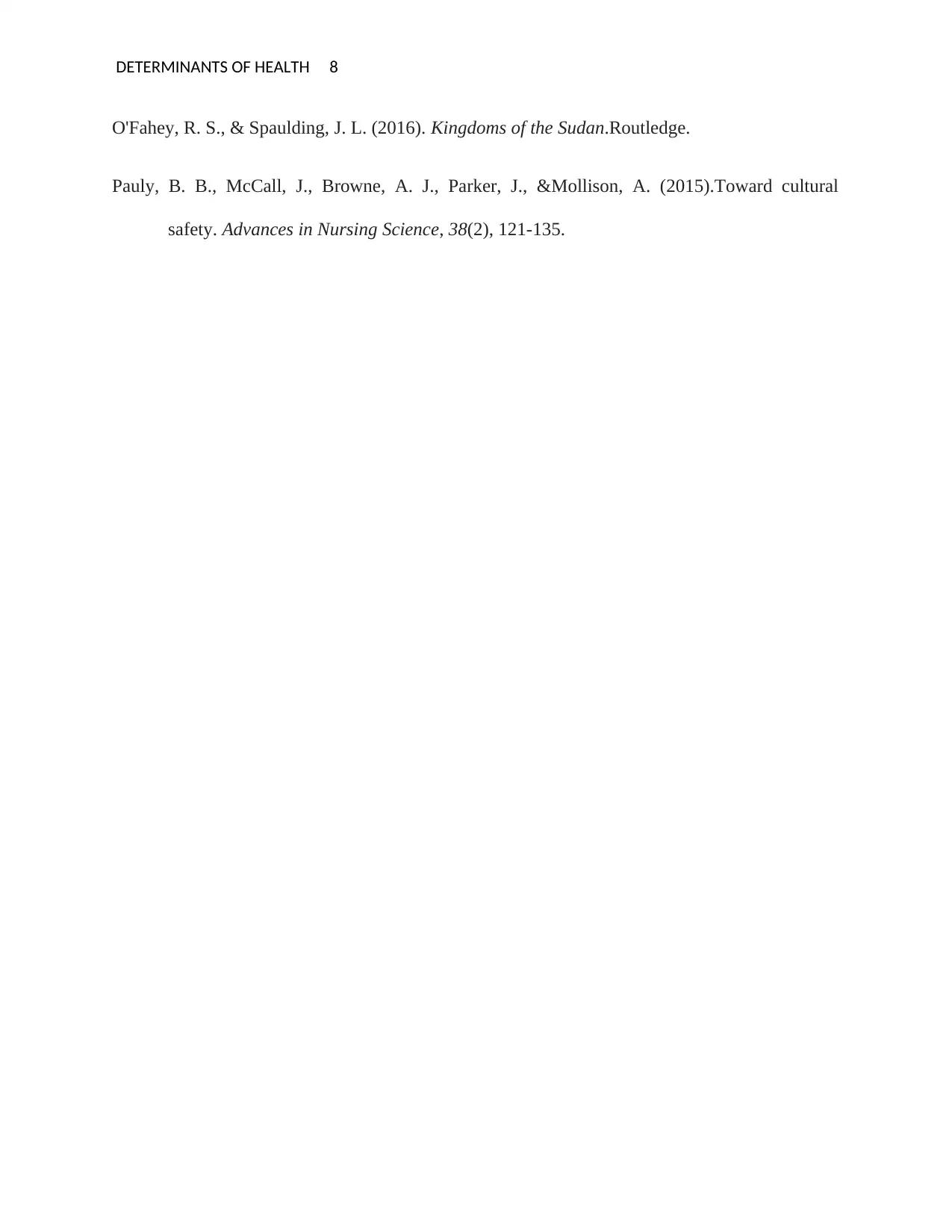
DETERMINANTS OF HEALTH 8
O'Fahey, R. S., & Spaulding, J. L. (2016). Kingdoms of the Sudan.Routledge.
Pauly, B. B., McCall, J., Browne, A. J., Parker, J., &Mollison, A. (2015).Toward cultural
safety. Advances in Nursing Science, 38(2), 121-135.
O'Fahey, R. S., & Spaulding, J. L. (2016). Kingdoms of the Sudan.Routledge.
Pauly, B. B., McCall, J., Browne, A. J., Parker, J., &Mollison, A. (2015).Toward cultural
safety. Advances in Nursing Science, 38(2), 121-135.
1 out of 8
Your All-in-One AI-Powered Toolkit for Academic Success.
+13062052269
info@desklib.com
Available 24*7 on WhatsApp / Email
![[object Object]](/_next/static/media/star-bottom.7253800d.svg)
Unlock your academic potential
Copyright © 2020–2025 A2Z Services. All Rights Reserved. Developed and managed by ZUCOL.

